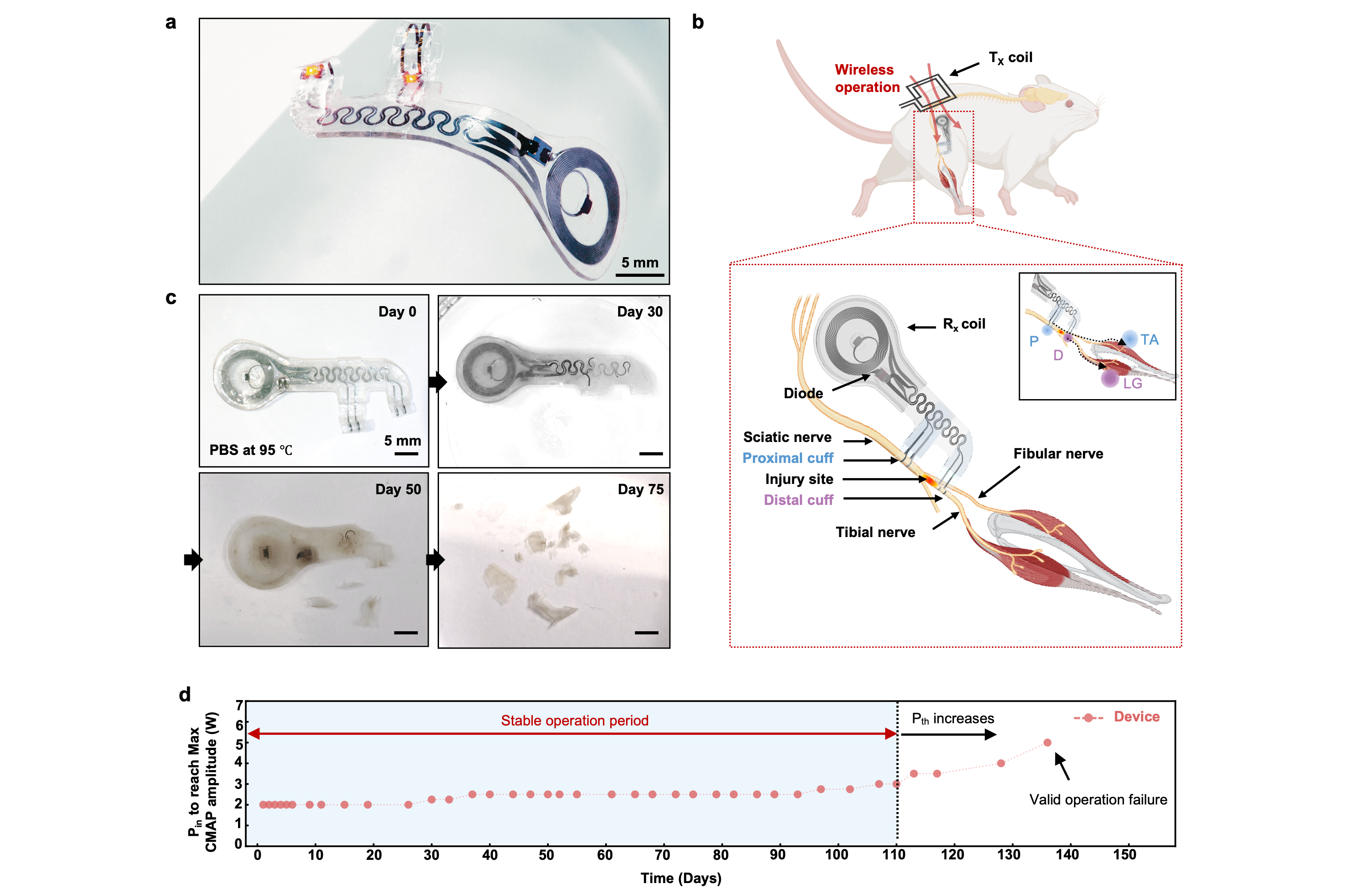Bioresorbable, wireless dual stimulator for peripheral nerve regeneration
Published in Bioengineering & Biotechnology, Electrical & Electronic Engineering, and Materials
Peripheral nerve injuries (PNIs) are common and can lead to muscle atrophy, impaired motor function, and sensory loss. While peripheral nerves are capable of regeneration, the process is often slow and incomplete. Conventional treatments, such as microsurgical repair and rehabilitation, frequently fail to fully restore function. This has led to growing interest in therapeutic electrical stimulation (TES), an electroceutical approach that delivers small electrical pulses to injured nerves to support regeneration. However, most existing devices depend on external hardware and wired interfaces, increasing infection risk, requiring hospitalization, and often necessitating device removal surgery placing a substantial burden on patients.

Wireless, bioresorbable, dual-site neuromodulation
To address these limitations, we developed a wireless, fully bioresorbable dual-site stimulator designed to operate for a prescribed treatment period and then safely disappear inside the body. The device is implanted during surgery at the injury site and does not require surgical retrieval after therapy completion.
Its core features include:
- Dual-site stimulation: Simultaneous stimulation of both the proximal and distal nerve stumps enhances regenerative outcomes. In vivo studies showed preserved muscle structure and improved nerve recovery.
- Wireless power transfer: Energy is delivered via magnetic induction from an external transmitter, enabling real-time, battery-free control of stimulation amplitude and frequency.
- Bioresorbable materials: The device is fabricated using soft, biocompatible materials that degrade naturally. Both operational time and degradation rate can be tuned through materials design.
Extended lifetime: Over 120 days of stable operation
By engineering improvements to the receiver coil and encapsulation, we achieved stable in vivo performance improvement of more than five times compared to previous platforms. Previous devices often degraded within 5–6 days, making them incompatible with long-term therapy. This advance opens the door to broader clinical applications, including chronic pain management, spinal cord stimulation, and deep brain stimulation (DBS), where extended electrical modulation is needed.
Early protection to long-term recovery: Proof of efficacy
We tested the stimulator in a rat sciatic nerve transection and repair model. At 1–2 weeks, DUAL stimulation preserved muscle cross-sectional area and fiber size significantly better than other groups. By 6 weeks, both DUAL and PROX groups showed enhanced muscle fiber regeneration, stronger CMAP responses, and reduced denervated fiber percentages compared to SHAM. These results highlight the importance of early intervention in reducing atrophy and promoting functional recovery over time.
A platform for precision, flexibility, and patient-centered care
This wireless, bioresorbable dual-site stimulator represents a next-generation electroceutical platform tailored for regenerative medicine, remote therapy, and personalized neuromodulation. The wireless design enables flexible, real-time adjustment of stimulation parameters based on the patient’s healing status—whether in a hospital or at home. With its extended operational lifetime, the device expands possibilities beyond peripheral nerves to more demanding applications in the brain, spinal cord. Battery-free operation and complete bioresorption support a patient-centered treatment model, eliminating the need for explant surgery and reducing clinical burden. Ultimately, we envision a future in which medical devices are precise, temporary, and harmonized with the body—delivering targeted therapy and then disappearing without a trace. This study marks a meaningful step toward realizing that vision.
Read the full article in Nature Communications: https://doi.org/10.1038/s41467-025-59835-7
Follow the Topic
-
Nature Communications

An open access, multidisciplinary journal dedicated to publishing high-quality research in all areas of the biological, health, physical, chemical and Earth sciences.
Related Collections
With Collections, you can get published faster and increase your visibility.
Women's Health
Publishing Model: Hybrid
Deadline: Ongoing
Advances in neurodegenerative diseases
Publishing Model: Hybrid
Deadline: Dec 24, 2025



Please sign in or register for FREE
If you are a registered user on Research Communities by Springer Nature, please sign in